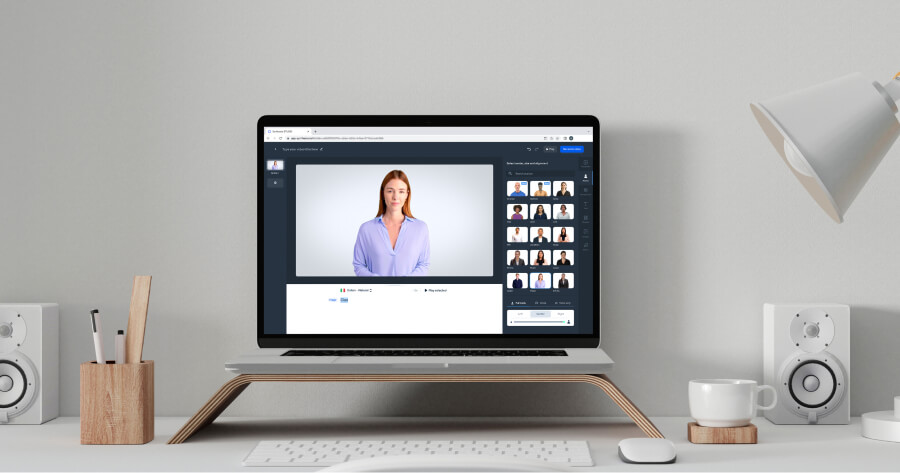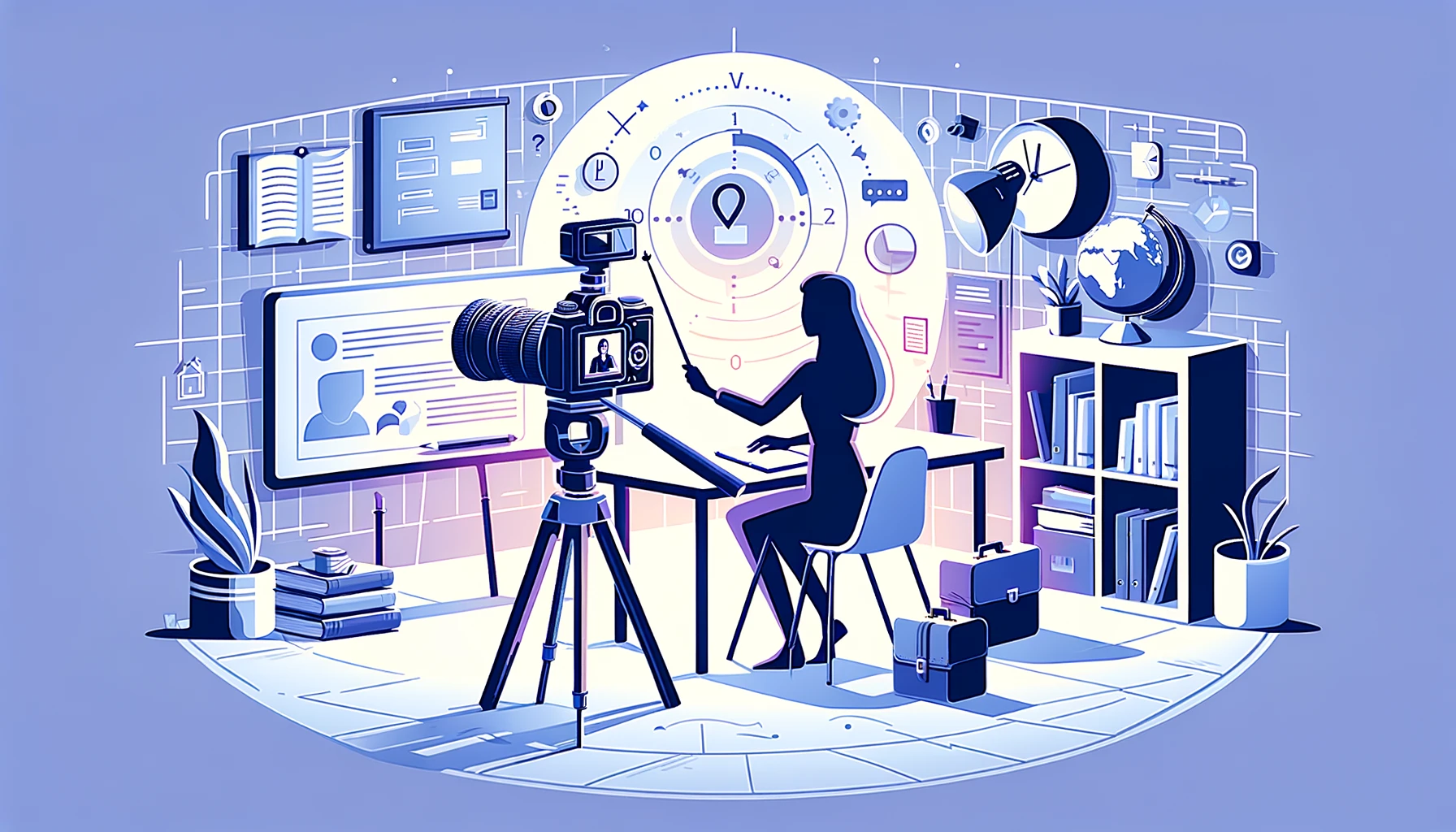
Create AI videos with 230+ avatars in 140+ languages.
When it comes to creating videos from raw footage, arguably the hardest part of the initial learning curve is editing.
Here's what the experienced gurus won't tell you... As a complete beginner, you don't need to waste time learning so-called "quick" editing hacks to edit videos. And you definitely don't need to spend months figuring out a pro video editor package like Adobe Premiere.
To edit video, what you need to learn is surprisingly simple:
- How to select the right software for your task. Videos for YouTube, TikTok, company training, customer testimonials, etc. all require different features and skill levels to edit. Sometimes you need that pro editor, but more often than not, you can use an easy-to-use online video maker to get the same effect.
- Lock down the basics of how you stitch footage together and tweak things like color, and transitions.
- Know how to put some audio on a track and export the video in the right format.
When doing video editing for the first time, it's all about keeping things simple. That way, you'll avoid analysis paralysis and get your first video out in less than a day.
Step 1. Plan and prepare
An hour of planning can save hours of doing 📈. Prepare for your video editing project by breaking up your planning phase into the following tasks:
- Gather your inspiration
- Choose the right video editing software
- Organize and back up your video footage
Gather your inspiration
First, determine your video's purpose — do you want it to inform, entertain, persuade, or share a special moment? The intent influences your video's atmosphere, tone, and message and the inspiration you need to search for.
Experienced editors create a mood board for atmosphere, gather reference edits they like, and pull up the storyboard if there is one. The storyboard visually lays out your video scene by scene, providing a structured guide for your edits.
No storyboard, no problem. Spend 30 minutes gathering reference edits — videos with a similar theme or any edits that inspire you to set the pacing and transitions in your video.
For beginners, the best inspiration often comes from templates.
These are a fantastic alternative to storyboards, and Synthesia includes 60+ video templates with applications ranging from training videos to explainer videos for marketing. Browsing templates will spark your creativity, and customizing one for your video will considerably simplify editing. Check out this demonstration to see how it works:
Choose the right video editing software
Video editing is pretty accessible these days, as the millions of videos uploaded daily to platforms like YouTube prove. So, you can pick plenty of easy-to-use tools from day one.
To create fun YouTube videos: iMovie (Apple devices only), DaVinci Resolve, and CapCut are all excellent free options.
To create videos for business: Consider using AI software like Synthesia. It's great for producing videos at scale with text-to-speech and AI avatars. There are also plenty of templates to help you get started.
To create short videos for social media: CapCut is an excellent all-around tool if you don't like the native options on Instagram or TikTok. Also try Opus's AI video creator if you have many long videos you'd like to shorten (like turning a podcast into a video snippet).
To create feature-length videos: If your videos are over 30 minutes in length and require lots of complex edits, invest time in learning a more robust and feature-rich professional video editor like Adobe Premiere, Davinci Resolve, or Final Cut Pro. Software like Synthesia can also help you out if you're creating slideshow-style lectures or demo tutorial videos.
Organize and back up your video footage
Searching for that perfect clip through hundreds of video files whose names don't tell you anything is no fun. So, step one of video editing is to organize your files on your computer. Gather all your photos, videos, and any additional media files like songs and sound effects into one organized folder on your computer and name your footage consistently. Use descriptive names, like "OfficeShot1", or try a year-month-day system.
Once organized, set up an automatic backup system over cloud storage like Google Drive or external hard drives. It's surprisingly common for footage to get corrupted. If you regularly save it, you'll always be able to revert to the files you need.
Step 2. Edit the rough cut
This is where the real work begins, and you finally open the software you chose in step 1. We'll go into each section in more detail, but here's the best way to think about the tasks before you when creating your first video:
- Import your footage & render proxies
- Drag and drop clips onto the timeline
- Include B-roll footage
- Add music and narration
- Add transitions and special effects
Import your footage & render proxies
Working in the actual video editor starts with importing the footage from your computer. So this will be the second step of organizing your footage, this time right in the video editor.
Drag and drop the video clips you want to edit and organize them into a media bin or folder (different terms in different editors). In this media bin, create folders to categorize and access footage more easily — you can separate footage for different scenes, types of shots (like close-ups or landscapes), or even days of shooting for bigger projects.
After organizing your clips, you'll notice that your system slows down when you try to play high-resolution footage. The computer will struggle to keep up with the data it gets, and the software will play the footage slowly or even freeze.
Thankfully, the video editor lets you render proxies. These lower-resolution versions of your clips save time and make editing easier. Depending on your software, you can set them up manually or automatically, but it's important that you do work with proxies instead of original footage.
Once you complete the video editing, the software will automatically export your video using the original high-resolution files.
Drag and drop clips onto the timeline
With all your clips organized in folders, drag and drop them onto the timeline. Position your clips in a logical sequence that effectively tells your story.
As you arrange the clips, use basic editing functions like cutting and trimming to remove unnecessary portions and keep your video engaging.
Cutting splits a clip into separate parts, which helps remove content or rearrange segments. Trimming adjusts a clip's start and end points to include only the best portions. These functions come with any video editor and are accessible with different keyboard shortcuts, depending on the platform.
Then, there are additional functions like snapping, which helps align clips with each other or with timeline markers, and setting in and out points, which define the selected portion of a clip for editing or playback.
As a beginner, first master the basic cut and trim. You can explore the advanced functions when you become more comfortable with the video editor.
Include B-roll footage
Supplement your main footage with B-roll shots to add depth, context, and visual variety. The right B-rolls will keep viewers engaged and visually stimulated.
Search for it in media libraries like Videvo, Pexels, Shutterstock, or Synthesia's built-in royalty-free library if you don't have the time or the resources to film your B-roll.
In Synthesia, you also have a unique feature called Space — a collection of background images reflecting different environments (office, outdoor, industrial spaces, etc.) that you can easily add to your video.
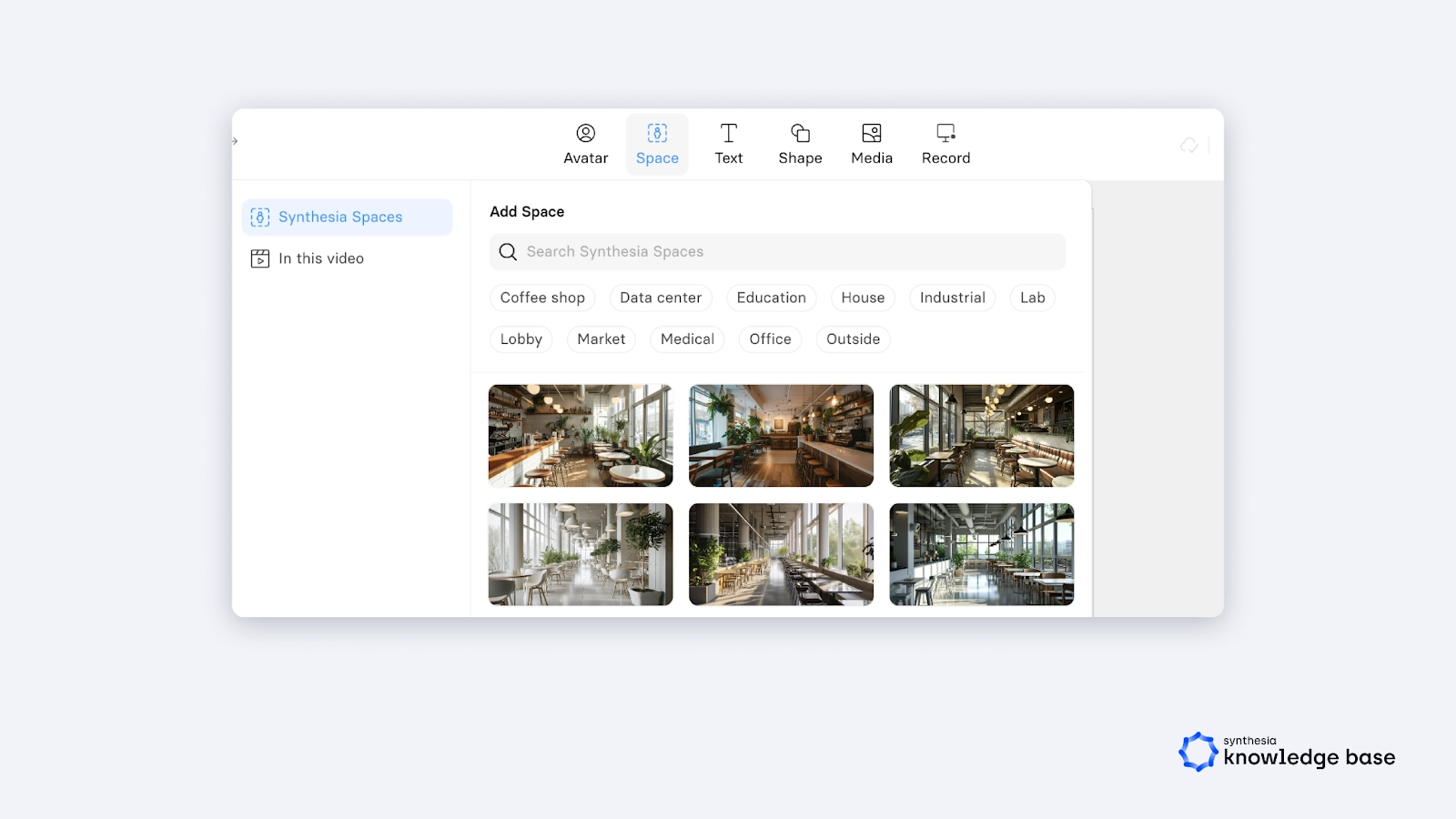
Add music and narration
There are many types of audio you can add to your video:
- Songs to keep people's attention and evoke emotion from viewers.
- Voiceover narration to explain the story or add more details.
- Dialogue captured during the recording of your footage.
- Foely sounds that add realism to the footage, such as footsteps, wind, or clinking glasses.
Even a simple video can have all four types of audio, so keep your audio files organized and easy to use.
The key when adding audio is to balance the DBS (volume) of the sounds to keep audio levels consistent and stick to one main audio track.
If your video includes music and dialogue, manage their volumes carefully — fade the music down when someone speaks and bring it back up once the dialogue ends to keep the narration clear and avoid having it drown in music. Some software can automatically isolate voices to make the narration clearer or filter out voices, leaving just the ambient sounds.
With an AI video editor, you'll significantly speed up the process of adding professional-grade audio to your video edit. Text-to-speech narration can generate a professional-sounding voiceover and help you easily align your script (audio) with the graphics for synchronized storytelling.
Add transitions and special effects
Once you've completed cutting and trimming your footage and after you've laid down the soundtrack, it's time to add transitions to your final cut. This sequencing ensures your transitions will complement both the images and audio.
Use transitions sparingly to create visual bridges between scenes and maintain a professional look:
- Simple fades to black or white can deliver a professional look at the end of your video.
- Jump cuts to skip predictable moments and maintain interest.
- Wipes or dissolves can help build tension or indicate the passage of time.
- Fade to black for the closure.
In most video editors, you have to drag and drop transition effects between two shots on the timeline to add it to your video. Then, you tweak it to obtain different effects, its length being one of the basic changes you can make — a shorter duration will create a quick, subtle shift, while a longer one can offer a more pronounced or dramatic change.
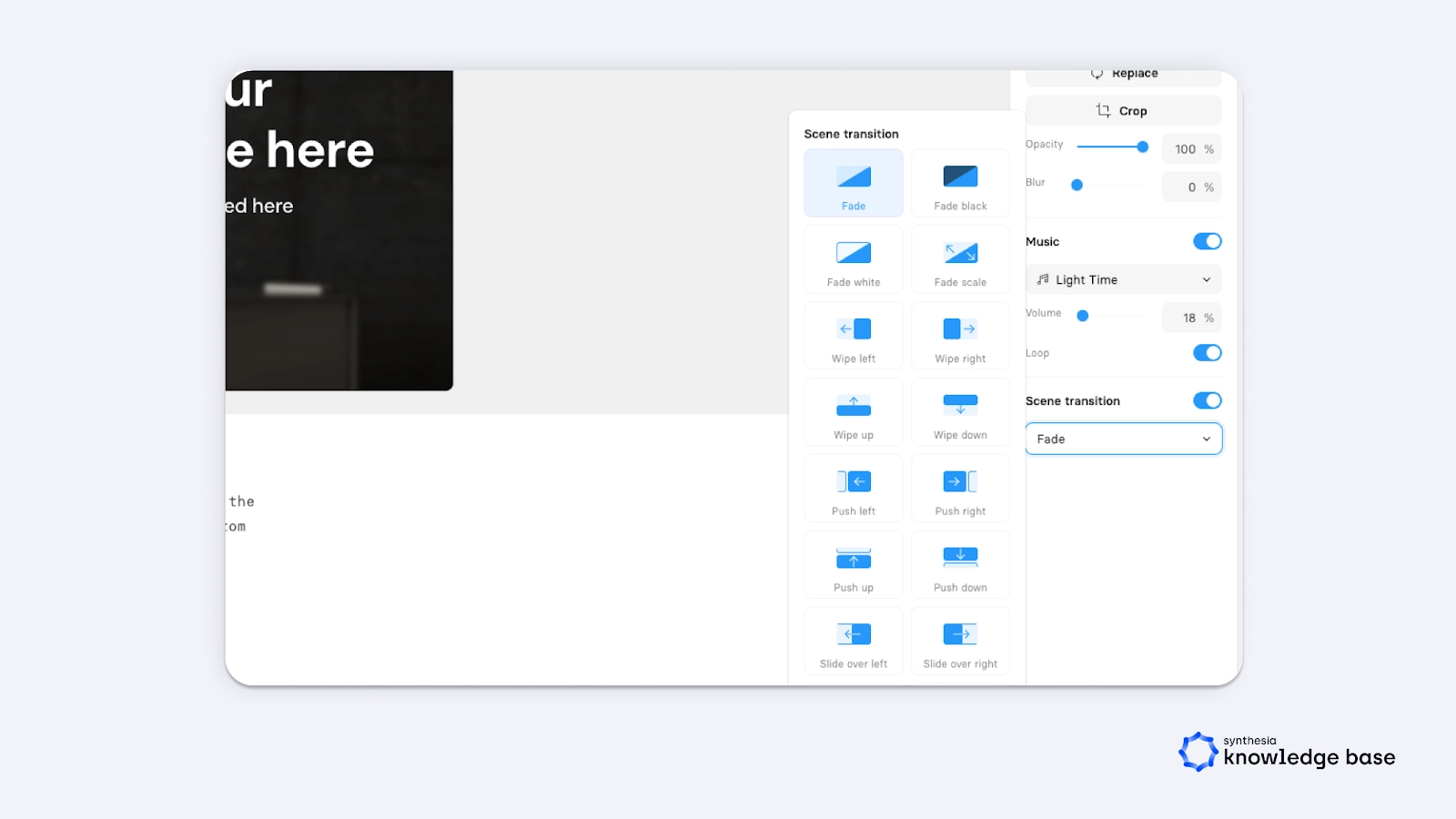
For example, Synthesia's video editor (pictured above) shows your video broken down into slides. Just click on the Scene transition toggle to enable transitions, and a dropdown menu of transition styles appears.
In addition to transitions, experiment with basic visual effects like slow motion, time-lapses, and overlays to add depth and interest. Start with simple effects to avoid making your video overwhelming.
Consider guiding viewers' eyes to key points in your video using techniques like zoom, pan, or tilt and annotations. See if you need to add arrows and highlights for further emphasis. Whatever effect you're using, always aim to enhance the storytelling aspect of your video without detracting from the content itself.
Step 3. Enhance your video
Now that you've got a coherent flow and know what scenes will show up in your video and in what order, add some pizzazz. Polish each scene and add different elements to make the video more engaging and convey your message:
- Add titles and text
- Do color correction
Add titles and text
Clear and concise titles, captions, and call-to-actions grab attention and guide viewers. The right editing software should make it easy, but some of them will have you tinker with these on-screen texts.
Many online video editors can simplify this process by auto-generating text like titles and captions. In Synthesia, for example, you can generate auto-captions and voice-overs from a script, customize their font, size, and timing, and even translate them into multiple languages for broader reach.
Do color correction
Color correction can improve the overall quality and reflect the mood and style you're looking for. Use your video editor to adjust colors and create a more professional, consistent look, starting with these two basic steps:
- Boost the contrast: This is often the first thing you do to define and separate the darks and lights, making your video more visually appealing. A simple way to adjust contrast is to add an S-curve using your editing software's color correction tool. It will darken the shadows and brighten the highlights, producing a more dynamic image.
- Balance the whites: This is crucial for achieving a natural look and maintaining consistency and accuracy in your video's color palette. Adjust the white balance settings to ensure white colors appear as true white under different lighting conditions.
With these adjustments, you will significantly improve the overall appearance of your video, making it look more professional and cohesive. Subtle changes can have a big impact, so it's best to make incremental adjustments and continually review your footage to ensure you're getting what you want.
Step 4. Polish and export
You're almost ready to share your video with the world! Just a final review and some last-minute optimizations, and you can export it:
- Review and refine
- Optimize for online viewing
- Export your video
Review and refine
Watch the full video. Is the message clear and easy to understand? Is the pacing right, allowing each scene to flow smoothly into the next? Are the scene lengths and transitions effectively keeping you engaged?
If all looks good and there are no technical glitches or errors, you're on the right path. Otherwise, go back to refining the video as many times as necessary until you get it right.
Doing multiple rounds of edits can be more or less complicated, depending on the options your video editor provides. With Synthesia, you can adjust and edit a video at any time without having to refilm scenes or even the entire video in case a mistake can't be corrected.
The AI avatars (digital doubles of real actors) are always camera-ready and filmed in perfect lighting. However, it's a good idea to make them feel even more human-like by customizing gestures, micro movement, and head angles. Check out the video to see how it works:
Optimize for online viewing
Different social media platforms require your videos to be uploaded in specific aspect ratios. Discover everything you need to know about aspect ratios and common video resolutions to use online in this ultimate guide to video aspect ratios. The gist of it is:
- 16:9, landscape format for YouTube videos.
- 9:16, portrait videos for IG reels, TikToks, and Facebook Stories.
- 1:1, square videos for LinkedIn, IG posts, and X (formerly Twitter).
- 4:5, tall videos for tall IG posts.
- 5:4, wide videos for LinkedIn, IG posts, and X.
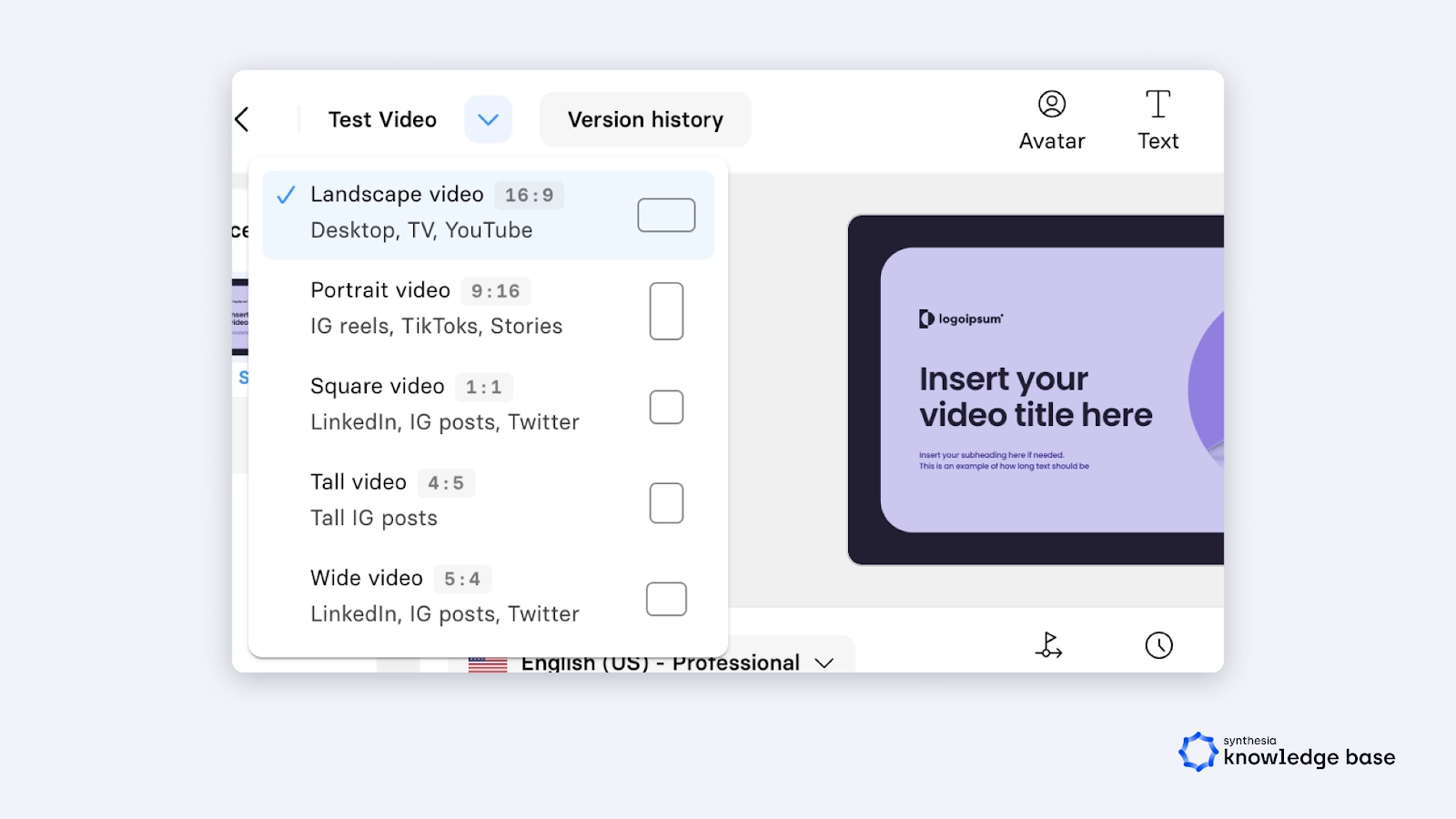
Export your video
When your video finally looks just how you want it, it's time to share it with the world. To do this, you'll need to "export" or save it in a format that others can easily watch.
In most video editors, it's best to export your video at a quality of 1080p (which means a pretty sharp image) and a frame rate of 30 frames per second (fps), ensuring smooth motion.
Use a web-friendly codec like H.264, which helps keep the file size manageable without sacrificing quality. If the video looks blocky or pixelated after exporting, render it again, but adjust the settings to improve the final video quality. This might include increasing the bitrate, choosing a higher resolution, or selecting a different codec to ensure a cleaner, more polished result.
Lastly, leverage the engagement tools different online video platforms offer. Many, including YouTube and web-based video editors, offer features like adding a call-to-action (CTA) on your video's share page or end screen. This can be anything from inviting viewers to subscribe to your channel, visit a website, or watch another video, helping you engage further with your audience.

Bonus tips when starting your first video editing project
You might be nodding along to this article, only to close the page, open your editing software, and freeze up in "wait... how does this work" analysis paralysis. If that sounds like you, then just keep these three tips in mind, and you'll be able to make progress.
Bonus tip 1: Keep it simple
Complexity can often lead to confusion, and the more complex the edits you're trying to make, the higher the odds that something will go wrong.
The best videos are the ones your audience understands and resonates with. So, just focus on a simple narrative structure and clean cuts, and your video will look better by default.
Bonus tip 2: Practice
Diving in and getting your hands dirty is the best way to learn. The more videos you edit, the more you'll learn and grow. Don't worry if your first projects aren't masterpieces. Experiment, try new things, and learn from your mistakes. Even the coolest editors started somewhere.
Bonus tip 3: Get feedback
Share your work with people you trust — friends, colleagues, online communities — and ask for their honest feedback. They might see things you missed, and their fresh perspective can help you make your video even better.
How to make professional-looking videos without any editing experience
The most compelling videos come across as authentic and simple. While you don't need overwhelming effects or complex editing to make your next video shine, you do need to worry less and just start practicing the simple steps outlined above.
With tools like the AI video maker Synthesia, generating professional-looking videos and editing them in minutes is accessible and enjoyable even for those without editing experience.
Use this free AI video maker to produce your own videos with AI video in minutes.
About the author
Learning Strategist & Speaker
Elly Henriksen
Elly Henriksen is a accomplished instructional designer exploring the impact of AI-generated content on learning design. With eight years of experience across both professional and higher education institutions, notably The University of Washington, Elly provides an insightful perspective on the transformative power of synthetic media for learners and instructional designer. Her versatile roles, from course facilitator to eLearning author and LMS administrator, give her a unique vantage point on the evolving trends in instructional design and how AI impacts the learning landscape. Explore Elly's insights and her pursuit of leveraging AI to redefine the future of the learning world.









